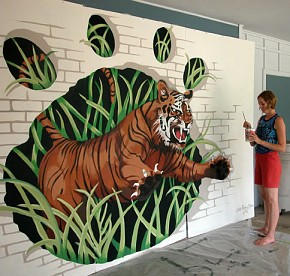A Guide to Painting Trompe L'oeil Murals
Are you looking for a fun and creative way to spice up the bland walls in your home or office? Then trompe l’oeil wall mural painting might be just the DIY art project you’ve been looking for.
Trompe l’oeil is French for "deceive the eye." This kind of painting uses specific layering and color techniques to create the illusion of rthree-dimensional imagery. Iconic examples of trompe l’oeil wall murals include an image of a boy climbing out of a picture frame or a faux view of the Mediterranean Sea. Add this type of wall mural to any room or hallway in your home and let your imagination run wild with different images to paint.
What You Need to Make Your Own Trompe L’oeil Murals
First, decide whether you want to paint your trompe l’oeil mural freehand or if you’ll feel more comfortable using an overhead projector to copy the image onto your wall. Those with less artistic experience will probably find it easier to copy the desired image onto transparency paper and then borrow or rent a projector to easily see how the painting should look. Then, collect the appropriate paintbrushes and paints — acrylic or flat interior paints are best — for your color scheme. (Stay away from glossy finishes.) You’ll also need primer, clear polyurethane, and containers to hold rinse water for your paintbrushes.
How to Paint a Trompe L’oeil Mural
Once you have all your art supplies, choose a wall for your mural. Light-colored backgrounds are best for this kind of project, so if the wall you want to use is a dark hue, give it a fresh coat of white or light-colored paint before you begin.
Next, apply a coat of primer to the entire mural area and allow to dry completely. In the meantime, set up your projector, if you’ll be using one. Once the primer has dried, sketch your mural freehand or use the projected image. After that, start painting the background first and layer the foreground images on top. Pay close attention to the shadows in your mural, as the shadowing is what will make the image more realistic. TIP: Outline the foreground images with darker colors so that the edges appear more vibrant.
You should periodically step back a few feet from the painting to check your progress and look for areas that need correcting. Once you are happy with your new trompe l’oeil mural painting, seal it with a coat of clear polyurethane to protect against scratching or other damage. Then you and your family can take pride in a beautiful, homemade wall mural that means much more than some purchased poster or painting.
Other Accent Walls
If you'd prefer a slightly different sort of wall treatment, check out these nine accent walls that you can create yourself. Or if you prefer, hire a professional painter to bring your design idea beautifully to life.
Updated April 12, 2018.
Looking for a Pro? Call us (866) 441-6648

Painting Average Costs
Painters Experiences

Air Conditioner Replacement In Florida’s 85-Degree Winter Weather

Concrete Patio Is The Finishing Touch For An Artist's Studio




